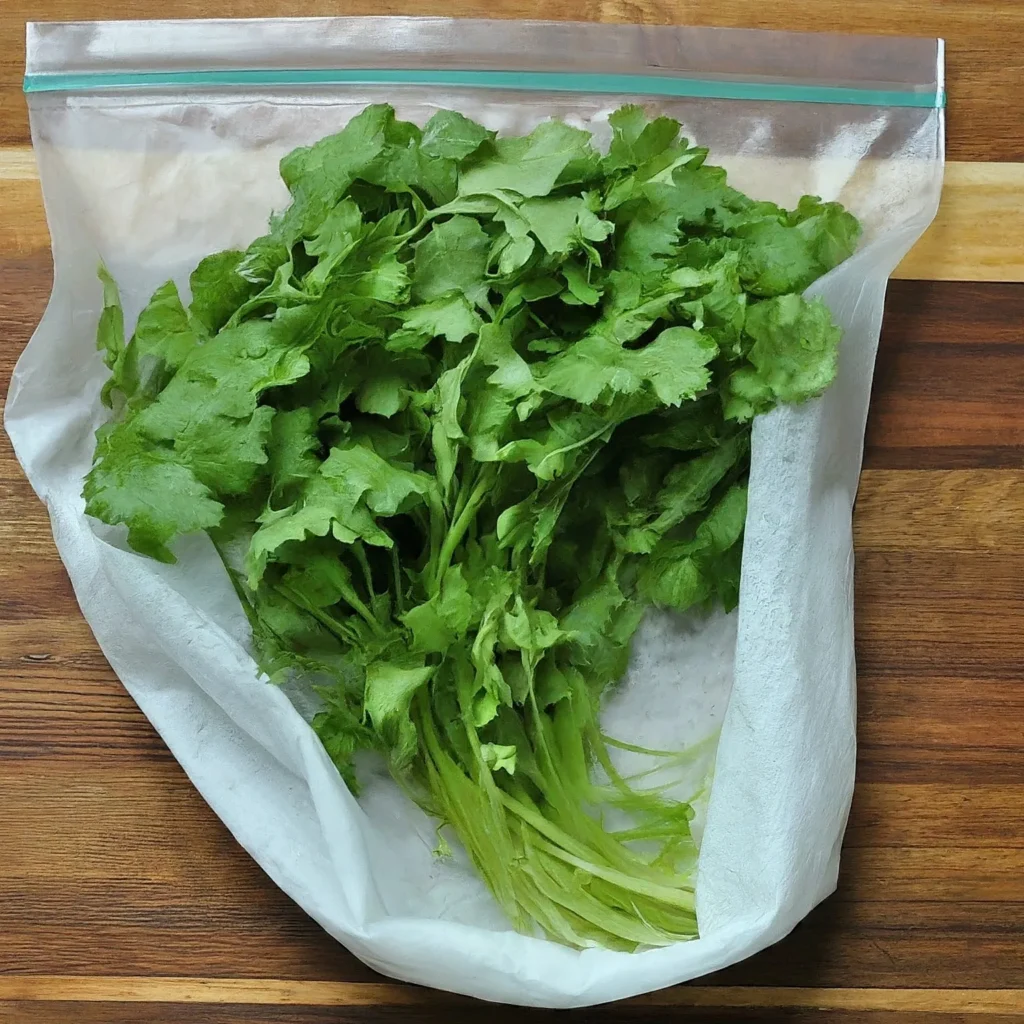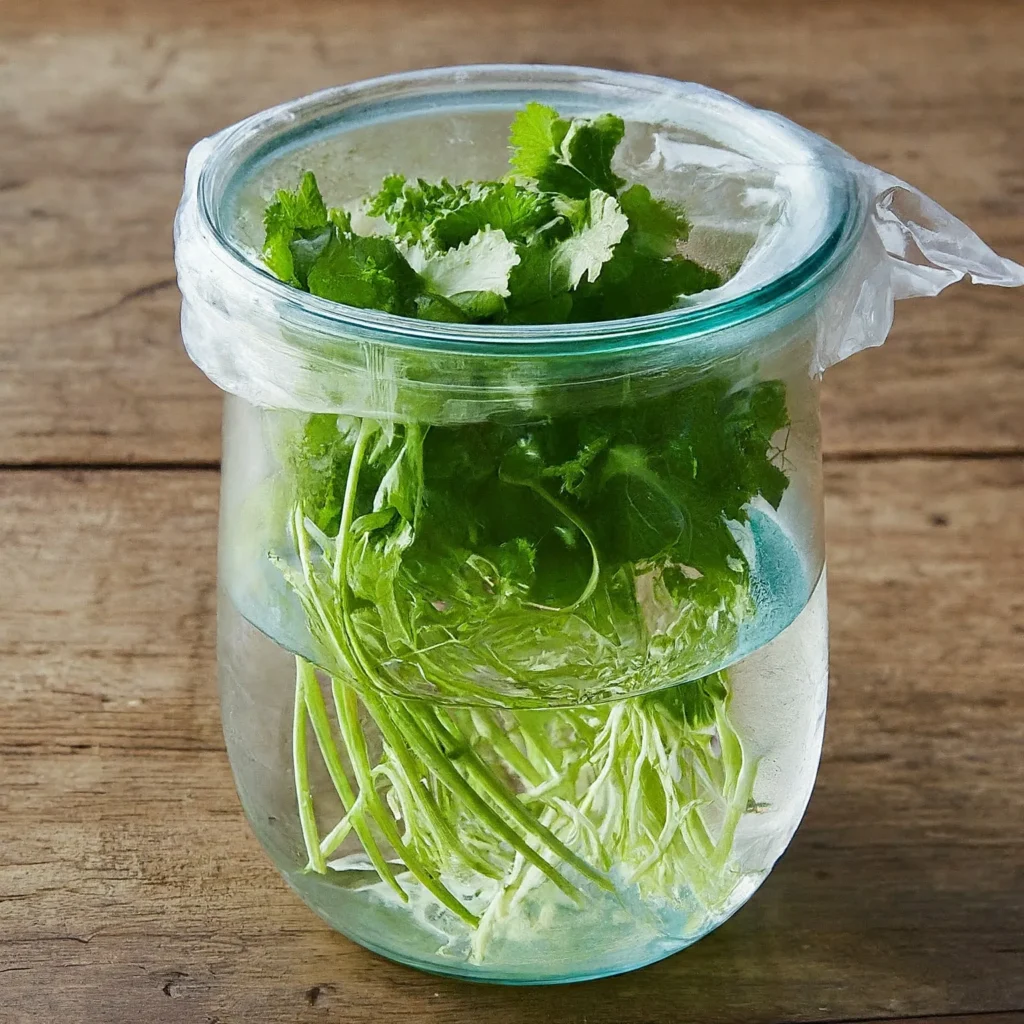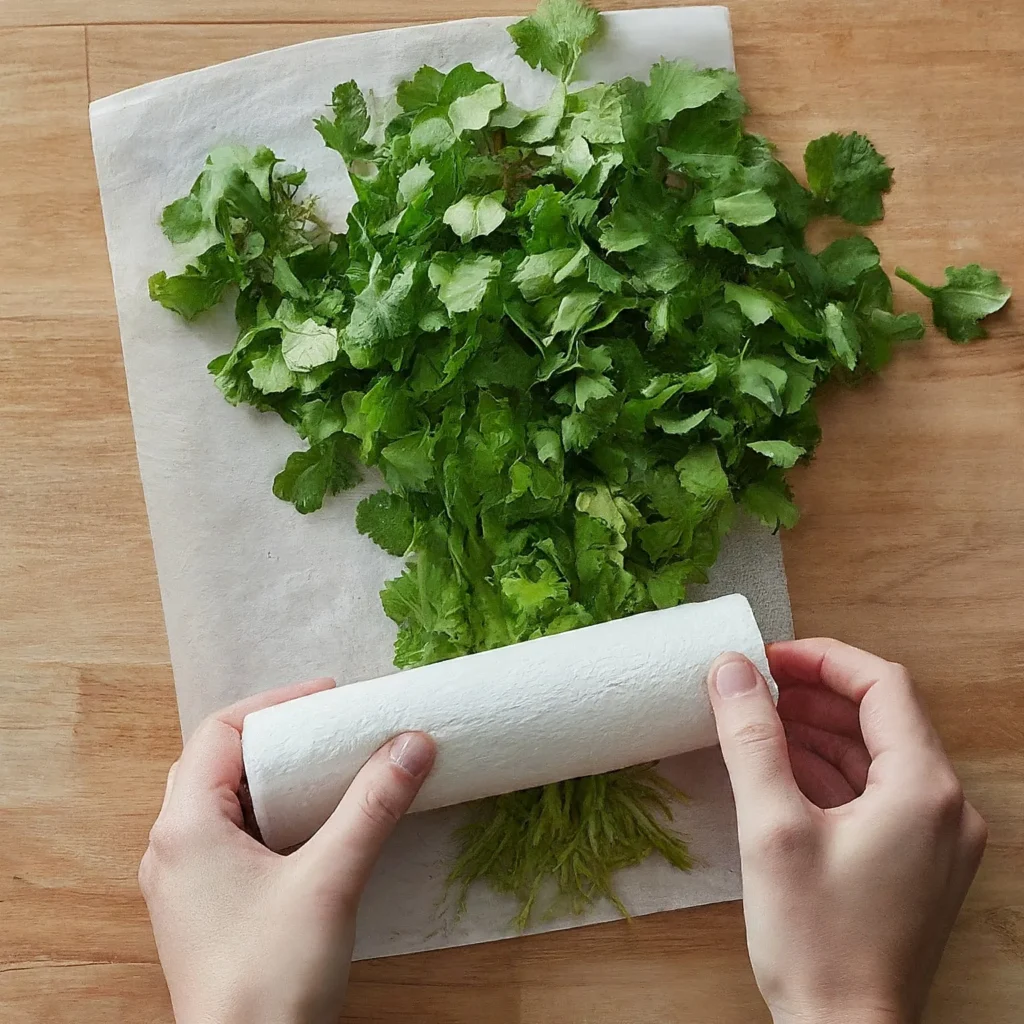Cilantro, with its vibrant green leaves and distinctive flavor, is a popular herb used in various cuisines. But keeping it fresh can be tricky. Fear not, fellow food enthusiasts! Here are some simple yet effective techniques to extend its shelf life:
The “Water” Method:
- Step 1: Trim the ends of the cilantro stems.
- Step 2: Place the bunch, stem-down, in a glass or jar filled with an inch of clean water.
- Step 3: Cover loosely with a plastic bag, creating a tent-like structure.
- Step 4: Refrigerate. Change the water every 2-3 days. This method can keep cilantro fresh for up to 2 weeks.
The “Paper Towel” Method:
- Step 1: Gently pat the cilantro dry with a clean paper towel.
- Step 2: Loosely wrap the cilantro in a paper towel, leaving space for air circulation.
- Step 3: Place it in a plastic bag, removing excess air.
- Step 4: Refrigerate. Replace the paper towel if it gets damp. This method can last for up to 1 week.
Freezing Cilantro:
- Step 1: Wash and thoroughly dry the cilantro.
- Step 2: Chop or leave whole, depending on your preference.
- Step 3: Flash-freeze by spreading on a baking sheet for 1-2 hours.
- Step 4: Transfer to an airtight container or freezer bag. This method can last for 3-4 months.
Bonus Tip: Store cilantro away from ethylene-emitting fruits like apples and bananas, as they can accelerate spoilage.
FAQs:
- Should I wash cilantro before storing it? It’s best to wait until used to wash cilantro, as moisture can accelerate spoilage.
- Can I store chopped cilantro? Yes, use the paper towel method, but it won’t last as long as the whole cilantro.
- How can I tell if cilantro is bad? Look for yellowing, wilting, or slimy leaves. Discard any cilantro with an off odor.
- What’s the best way to use frozen cilantro? Add it directly to cooked dishes while frozen.
By following these tips, you can enjoy the fresh flavor of cilantro for longer, adding a vibrant touch to your culinary creations!
Table of Contents
ToggleBenefits of Cilantro:
- Rich in nutrients: Cilantro is a good source of vitamins A, C, and K, as well as essential minerals like manganese and potassium.
- Antioxidant properties: Studies suggest cilantro may offer antioxidant benefits, potentially protecting cells from damage.
- Potential health benefits: Some research indicates cilantro may help lower blood sugar and cholesterol levels, although more research is needed.
Side Effects of Cilantro:
- Allergic reactions: While rare, some individuals may experience allergic reactions to cilantro, including skin rashes and breathing difficulties.
- Interaction with medications: Cilantro may interact with certain medications, such as blood thinners. Consult your healthcare provider if you have concerns.
Comparison Table: Storage Methods for Cilantro
| Method | Steps | Shelf Life |
|---|---|---|
| Water Method | Dry cilantro, wrap loosely in a paper towel, place in a plastic bag, refrigerate, and replace paper towel if damp. | Up to 2 weeks |
| Paper Towel Method | Wash, dry, chop, or leave whole, flash-freeze, and store in an airtight container. | Up to 1 week |
| Freezing Method | Wash, dry, chop or leave whole, flash-freeze, and store in an airtight container. | 3-4 months |

Does cilantro last longer in a jar?
While storing cilantro in a jar with water can extend its shelf life compared to leaving it loosely in the fridge, it’s not necessarily the absolute best method. Here’s a breakdown:
Pros of using a jar:
- Longer shelf life: The water method, using a jar, generally keeps cilantro fresh for up to 2 weeks, which is longer than the paper towel method’s 1 week.
- Easy to manage: It allows you to easily monitor the water level and change it every few days.
Cons of using a jar:
- More maintenance: Requires changing the water and washing the jar regularly.
- Not always the best: Compared to the 3-4 months possible with freezing, the jar method falls short in terms of long-term storage.
So, does cilantro last longer in a jar? Compared to just storing it loose in the fridge, yes. However, for absolute longevity, freezing is the clear winner. Ultimately, the best method depends on your needs and preferences:
- Need fresh cilantro for the next few weeks? The jar method is a good choice.
- Want to have cilantro readily available for a longer period? Freezing is the way to go.
- Need to use up cilantro quickly or value the convenience? The paper towel method might suffice.
Remember, regardless of the method, always store cilantro away from ethylene-emitting fruits and choose the method that best suits your needs for fresh, flavorful cilantro!
How do you keep cilantro good in the fridge?
Keeping cilantro fresh in the fridge requires creating the right environment to combat its natural tendency to wilt. Here are two effective methods:
Method 1: The “Water Bath”
- Trim the stems: Gently remove any yellowing leaves and trim about an inch off the stems.
- Fill a jar with water: Use a clean jar or glass and fill it with approximately one inch of cool water.
- Place the cilantro upright: Submerge the stems in the water, positioning the leaves above the waterline, similar to how you would arrange flowers in a vase.
- Cover loosely: Secure a plastic bag loosely around the top of the jar, creating a tent-like structure. This allows air circulation while preventing excessive moisture loss.
- Refrigerate and change water: Place the jar in the crisper drawer of your fridge. Change the water every 2-3 days to keep it fresh and prevent bacterial growth.
Method 2: The “Paper Towel Wrap”
- Pat dry gently: Wash the cilantro if necessary, but ensure it’s thoroughly dry. Gently pat the leaves with a clean paper towel to remove any excess moisture.
- Wrap loosely: Wrap the dry cilantro loosely in a clean paper towel. Don’t pack it tightly as air circulation is crucial.
- Store in a plastic bag: Place the wrapped cilantro in a zip-lock bag or reusable container, removing as much air as possible before sealing.
- Refrigerate and replace paper towel: Store the bag in the crisper drawer of your fridge. Replace the damp paper towel every 2-3 days to prevent wilting.
Bonus Tip: Store your cilantro away from ethylene-emitting fruits like apples and bananas, as they can accelerate spoilage.
Additional Tips:
- Use older cilantro first: If you have multiple bunches of cilantro, prioritize using the older ones first to avoid waste.
- Freshen up wilted cilantro: If your cilantro starts to wilt slightly, try soaking it in cold water for 10-15 minutes. This can help revive its crispness.
- Consider freezing for long-term storage: If you need to preserve cilantro for longer than a few weeks, consider freezing it. While this method affects the texture, it’s a great way to have cilantro readily available for future use.
By following these tips and choosing the method that suits your needs, you can enjoy fresh, flavorful cilantro for longer!

In Conclusion:
Cilantro is a versatile and flavorful herb, but proper storage is key to maximizing its freshness and enjoyment. Experiment with the storage methods mentioned above to find the one that best suits your needs. Remember to be mindful of potential side effects and consult a healthcare professional if you have any concerns.
With these tips, you can confidently add a touch of freshness and flavor to your meals using cilantro!










